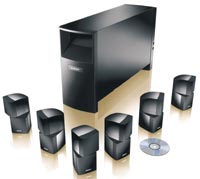 Here’s the introduction to a forthcoming review of mine to appear in The Canberra Times:
Here’s the introduction to a forthcoming review of mine to appear in The Canberra Times:
If you look around the Internet you will find Web sites that aim to ‘tell the truth’ about particular businesses and products. So you will find sites exposing Scientology, Amway and … Bose! What is it about Bose that gets up the nose of some audiophiles?Can you get better sound for fewer dollars than Bose provides? For sure. Does Bose inflate its quality somewhat in its promotional literature? Absolutely, but then do almost all other companies.
So let’s keep things in perspective. Bose’s subwoofer/satellite systems aren’t the best value for money, nor the world’s most accurate speaker system, but they fill a need that many people find more important: good sound quality from inconspicuous speakers.
I should add that Bose is, in engineering terms, a thoughtful company. There are little things that many more highly reputed companies either don’t think about, or seem to consider to be someone else’s problem. Specifically, Bose’s Acoustimass speaker systems manage the satellite/subwoofer crossover themselves. Many other sub/sat systems rely on the receiver’s crossover. The problem there is that more than half home theatre receivers use a fixed 80 hertz crossover, which is far too low for small satellites.
Okay, even Bose isn’t perfect in this crossover region (my measurements on the Acoustimass 16 Series II show the 110-220 hertz region down around 6dB from the overall level), but it at least attempts to deal with this. The remarkably good value JBL Simply Cinema SCS 20, for example, suffers a 9dB drop from 75 to 220 hertz when connected to a regular receiver. And similar designs suffer similar problems.
